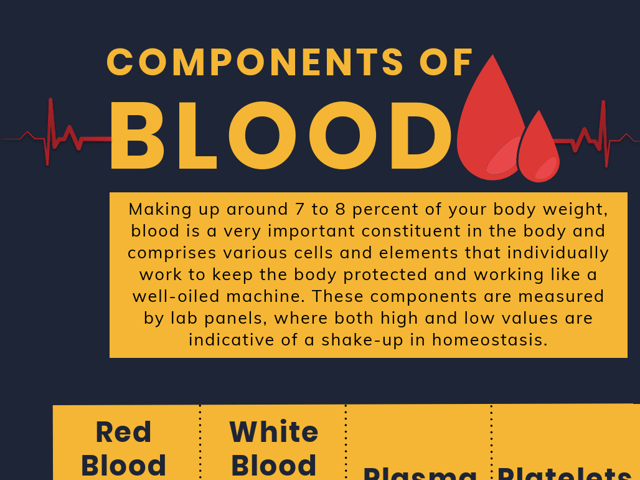
Components of Blood
What Is Blood?
Making up around 7 to 8 percent of your body weight, blood is a very important constituent in the body and comprises various cells and elements that individually work to keep the body protected and working like a well-oiled machine. These components are measured by lab panels, where both high and low values are indicative of a shake-up in homeostasis.
Red Blood Cells
These are also known as erythrocytes and account for 40-45 percent of the blood’s volume as well as its rich, red color. These flexible, donut-shaped discs easily maneuver through various pathways in blood vessels. They are produced by a hormone in the kidney, erythropoietin, and are stored in bone marrow for about a week, at which time they are released into the bloodstream. They have two primary functions: (1) to deliver oxygen via a protein, hemoglobin, from the lungs to all the other organs in the body and (2) take carbon dioxide from organs back to the lungs to be exhaled. A normal range is from 4 to 5.5 M/uL for red blood cells and 12 to 17.4 g/dL for hemoglobin. High results are indicative of diseases that cause an increase in production such as polycythemia vera, kidney tumors, and lung disease. Low values would be typical for anemia.
White Blood Cells
These cells are also known as leukocytes and are the defense line for the body. They normally only make up roughly 1 percent of blood volume. Neutrophils, as well as T and B lymphocytes, make up the white blood cell population. Each cell type has a complex and specific task of protecting the body from infection whether it be bulking the immune system or directly fighting foreign cells. A normal range for white blood cells is 5 to 10 K/uL. A high value typically indicates an infection somewhere in the body. A low value would indicate things such as neutropenia, which increases your risk for diseases and infections due to a weak immune system.
Plasma
This is the liquid component in blood that is a blend of water, salt, fat, and protein. This fluid substance is in charge of the transport of everything in blood to its destination. For example, it transports the waste in blood to the liver and kidneys to be filtered out of the body. While plasma itself is not measurable, some of its pieces are, such as proteins. Several types of proteins can be measured, but albumin is the most predominant one, making up around 55 percent of protein volume in blood. A normal range for albumin is 3.5 to 5.5 g/dL. Low levels of this protein are indicative of malnutrition. High levels can mean infection and/or inflammation.
Platelets
Also called thrombocytes, these are pieces of cells whose job is to help blood to clot at a site of injury. The fragments stick together to form a foundation for the blood to clot. A normal value range for platelets is 140 to 400 K/uL. When these values are high, it means the body is making too many clots. This puts the individual at risk for conditions such as stroke, heart attack, deep vein thrombosis, and pulmonary embolism. Values that are low indicate poor clotting, also known as thrombocytopenia, which increases one’s risk of losing too much blood.

Keep Reading

Test of Essential Academic Skills Blog
How to Pass the TEAS Science Section
As a pivotal component of the Test of Essential Academic Skills (TEAS),…

Test of Essential Academic Skills Blog
How Long Should I Study for the TEAS Test?
According to the Bureau of Labor, there are over 3 million registered n…

Test of Essential Academic Skills Blog
Making a Studying Plan for the TEAS Exam
Are you preparing to take the ATI TEAS exam? This important test can be…